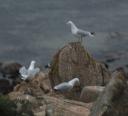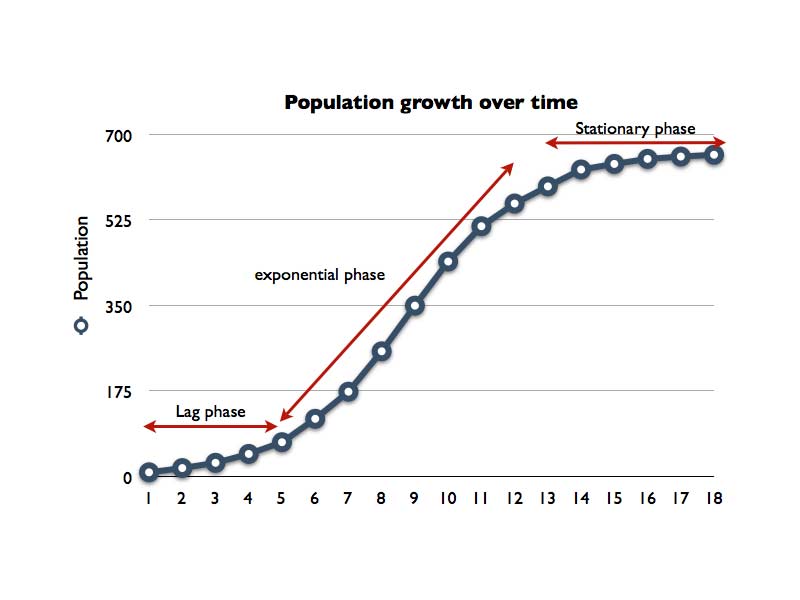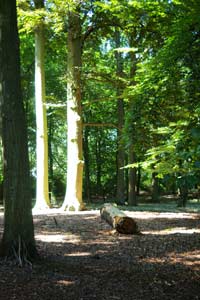2.1. 7: Population interactions
COMPETITION
1. All the organisms in any ecosystem have some effect on every other organism in that ecosystem.
2. Also any resource in any ecosystem exists only in a limited supply.
When these two conditions apply jointly, competition takes place.
 In a seagull colony on an oceanic outcrop, as the population grows, so the pressure for good nesting sites increases. This can affect the number of eggs that each female can successfully hatch, and so affects the birth rate of the population as a whole. This sort of interaction is called a Density Dependent factor - the effect is depends on the population density ( low density small effect, high density large effect). This mainly associated with pressure for food, nutrients or space.
In a seagull colony on an oceanic outcrop, as the population grows, so the pressure for good nesting sites increases. This can affect the number of eggs that each female can successfully hatch, and so affects the birth rate of the population as a whole. This sort of interaction is called a Density Dependent factor - the effect is depends on the population density ( low density small effect, high density large effect). This mainly associated with pressure for food, nutrients or space.
Competition between members of the same species is INTRASPECIFIC COMPETITION.
When the numbers of a population are small, there is little real competition between individuals for resources. Provided the numbers are not too small for individuals to find mates, population growth will be high.
 As the population grows, so does the competition between individuals for the same resources until eventually the carry capacity of the ecosystem is reached. In this situation, often the stronger individuals claim the larger share of the resources.
As the population grows, so does the competition between individuals for the same resources until eventually the carry capacity of the ecosystem is reached. In this situation, often the stronger individuals claim the larger share of the resources.
Some species deal with intraspecific competition by being territorial. An individual or pair hold an area and fend off rivals. Individuals that are the most successful reproductively will hold the biggest territory and hence have access to more resources.
 Intraspecific competition tends stabilize populations dependent upon the controlling resources. It produces something called logistic growth. The graph illustrates this for a colony of yeast grown in a constant but limited supply of nutrient. During the first few days the colony grows slowly as it starts to multiply (lag phase) then it starts to grow very rapidly as the multiplying colony has a plentiful nutrient supply (exponential phase). Eventually the population size stabilizes as only a set number of yeast cells can exploit the limited resources (stationary phase). Anymore yeast cells and there is not enough food to go around.
Intraspecific competition tends stabilize populations dependent upon the controlling resources. It produces something called logistic growth. The graph illustrates this for a colony of yeast grown in a constant but limited supply of nutrient. During the first few days the colony grows slowly as it starts to multiply (lag phase) then it starts to grow very rapidly as the multiplying colony has a plentiful nutrient supply (exponential phase). Eventually the population size stabilizes as only a set number of yeast cells can exploit the limited resources (stationary phase). Anymore yeast cells and there is not enough food to go around.
Competition does not only occur between individuals of the same species. Individuals of different species could be competing for the same resource.
This is INTERSPECIFIC COMPETITION.
Interspecific competition may result in a balance, in which both species share the resource. The other outcome is that one species may totally out compete the other, this is the principal of competitive exclusion. An example of both of these outcomes can be seen in a garden that has become overrun by weeds. A number of weed species coexist together, but often the original domestic plants have been totally excluded.
 In a woodland light is a limiting resource. Plant species that can not get enough light will die out in a woodland. This is especially true of small flowering plants on the woodland floor that are not only shaded out by trees but by shrubs and bushes as well. Beech trees have very closely overlapping leaves, resulting in an almost bare woodland floor.
In a woodland light is a limiting resource. Plant species that can not get enough light will die out in a woodland. This is especially true of small flowering plants on the woodland floor that are not only shaded out by trees but by shrubs and bushes as well. Beech trees have very closely overlapping leaves, resulting in an almost bare woodland floor.
 But even in beech woods flowers manage to grow in the spring. Carpets of Snowdrops, Primroses and Bluebells an integral part of all Northern European deciduous woodlands in the spring. The key to these species success is that the grow, flower and reproduce before the shrub and tree species burst into leaf. They avoid competing directly with species that would out compete them for light by completing the stages of their yearly cycle that require the most energy and therefore the greatest photosynthesis when competition is less.
But even in beech woods flowers manage to grow in the spring. Carpets of Snowdrops, Primroses and Bluebells an integral part of all Northern European deciduous woodlands in the spring. The key to these species success is that the grow, flower and reproduce before the shrub and tree species burst into leaf. They avoid competing directly with species that would out compete them for light by completing the stages of their yearly cycle that require the most energy and therefore the greatest photosynthesis when competition is less.
The above animations were made by S Thomas